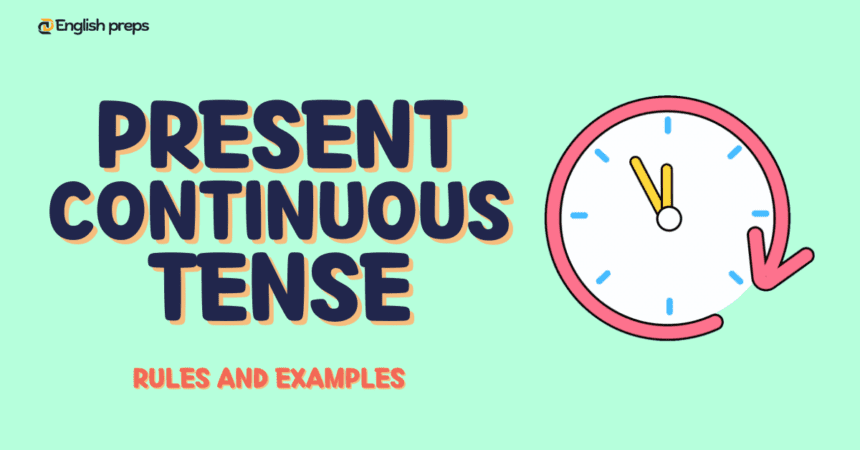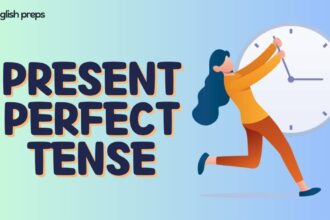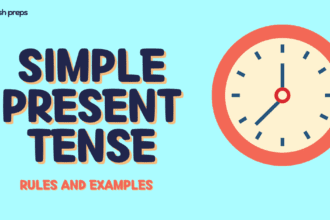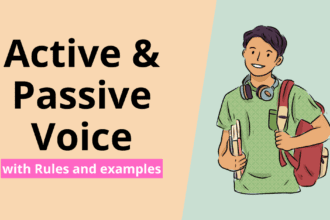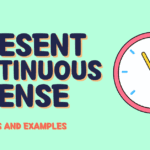The Present Continuous Tense, also known as the Present Progressive Tense, is a verb form used to describe actions or situations that are currently happening at the moment of speaking. In English, it is formed by using the present tense of the verb “to be” (am, is, are) followed by the base form of the main verb plus the -ing suffix.
For example:
- I am writing.
- She is studying.
- They are playing football.
Table of Contents
When Present Continuous Tense is used?
The Present Continuous tense describes actions or situations that are happening at the moment of speaking, actions or situations that are currently in progress, or actions or situations that are planned or arranged for the future. Here are some specific situations when the Present Continuous tense is commonly used:
1. Actions Happening Now:
To describe actions or events that are occurring at the present moment.
Examples:
- She is reading a book right now.
- She is cooking dinner in the kitchen.
- They are playing basketball at the park.
- He is talking to his boss on the phone right now.
2. Temporary Situations:
To describe temporary actions or situations that are occurring around the present time.
Examples:
- I am staying with my friend until I find a new apartment.
- She is working as a waitress while she looks for a job in her field.
- We are living in a hotel while our house is being renovated.
3. Future Arrangements:
To talk about future events or actions that are already planned or arranged.
Example:
- We are meeting for lunch at noon tomorrow.
- He is attending a conference in New York next month.
- They are flying to Paris next week for their vacation.
4. Repetitive Actions (often annoying):
To describe repetitive actions that are happening now and may be irritating.
Examples:
- They are constantly talking loudly in the library.
- She is always clicking her pen during meetings.
- He is forever forgetting to turn off the lights when he leaves the room.
5. Changing or Developing Situations:
To describe situations that are changing or developing over time.
Examples:
- The weather is getting colder as winter approaches.
- The flowers are blooming as spring arrives.
- The river is flooding due to heavy rainfall in the region.

Structure of the Present Continuous Tense
The structure of the Present Continuous Tense in English consists of two main components:
- Present Tense of the Verb “to be” (am, is, are):
- “I am”
- “You are”
- “He/She/It is”
- “We are”
- “They are”
- Base Form of the Main Verb + “-ing” suffix:
- Example: “play” becomes “playing”, “work” becomes “working”, “study” becomes “studying”
Putting it together, the general structure for forming the Present Continuous Tense is:
- Subject + is/are/am + Base form of main verb + “−ing” suffix + Rest of the Sentence
Examples:
- I am writing.
- You are studying.
- He is playing football.
- She is reading a book.
- We are cooking dinner.
- They are watching a movie.
How to Form Negative Sentences in the Present Continuous Tense?
To form negative sentences in the Present Continuous Tense in English, you typically follow this structure:
- Subject + is/are/am + not (am not, is not, are not) + Base form of main verb + “−ing” suffix + Rest of the Sentence
Here’s a breakdown of the steps:
- Select the Subject: Choose the appropriate subject for your sentence.
- Choose the Present Tense of “to be”: Select the correct form of “to be” based on the subject:
- “am not” for the first person singular (I)
- “is not” for the third person singular (he, she, it)
- “are not” for the second person singular and plural (you) and third person plural (they)
- Add the Base Form of the Main Verb + “-ing”: Use the base form of the main verb and add the “-ing” suffix to form the present participle.
- Complete the Sentence: Add the rest of the sentence after the present participle.
Here’s an example:
- Positive: “She is playing soccer.”
- Negative: “She is not playing soccer.”
In the negative form, “is not” is used to negate the action, and “playing” remains in the present participle form.
Remember that when forming negative sentences in the Present Continuous Tense, you add “not” after the present tense form of “to be” to indicate the negation of the action or situation described by the verb phrase.
How to Form Interrogative Sentences in the Present Continuous Tense?
To form interrogative sentences in the present continuous tense in English, you typically use the auxiliary verb “am,” “is,” or “are” at the beginning of the sentence, followed by the subject, and then the main verb with the -ing form. Here’s the basic structure:
- Auxiliary Verb + Subject + Main Verb + -ing + Rest of sentence +?
Here are some examples:
- Am I eating dinner?
- Is she reading a book?
- Are they playing football?
- Is it raining outside?
- Are we having a meeting?
In each of these examples, the auxiliary verb (“am,” “is,” or “are”) comes before the subject, and the main verb is in its -ing form. Additionally, a question mark is used at the end to denote that it’s an interrogative sentence.
How to Form Negative Interrogative Sentences in the Present Continuous Tense?
To form negative interrogative sentences in the present continuous tense in English, you use the auxiliary verb “am not,” “is not,” or “are not” (contracted as “isn’t,” “aren’t,” “isn’t”) before the subject, followed by the main verb in its -ing form. Here’s the structure:
- Auxiliary Verb (Negative) + Subject + Main Verb + -ing + Rest of sentence +?
Here are some examples:
- Aren’t you eating dinner?
- Isn’t she reading a book?
- Aren’t they playing football?
- Isn’t it raining outside?
- Aren’t we having a meeting?
In each of these examples, the negative auxiliary verb (“aren’t” or “isn’t”) comes before the subject, followed by the main verb in its -ing form. Additionally, a question mark is used at the end to denote that it’s an interrogative sentence.

Here’s a table outlining the structure of the Present Continuous Tense for positive sentences, negative sentences, interrogative sentences, and negative interrogative sentences, along with examples:
| Sentence Type | Structure | Example |
|---|---|---|
| Positive Sentences | Subject + am/is/are + Verb-ing + Rest of sentence | I am reading a book. He is eating lunch. They are playing soccer. |
| Negative Sentences | Subject + am/is/are + not + Verb-ing + Rest of sentence | I am not studying right now. She is not watching TV at the moment. We are not going to the party tonight. |
| Interrogative Sentences | Am/Is/Are + Subject + Verb-ing + Rest of sentence +? | Are you reading a book? Is he eating lunch? Are they playing soccer? |
| Negative Interrogative Sentences | Am/Is/Are + not + Subject + Verb-ing + + Rest of sentence +? | Aren’t you studying right now? Isn’t she watching TV at the moment? Aren’t we going to the party tonight? |
These examples demonstrate the various forms of the Present Continuous Tense in different sentence types.
Rules to Remember When Using the Present Continuous Tense
When using the present continuous tense in English, there are several rules to remember:
- Formation of the Present Continuous Tense:
- The present continuous tense is formed using the present tense of the verb “to be” (am/is/are) + the base form of the main verb + -ing suffix.
- Use for Actions Happening Now:
- The present continuous tense is used to describe actions or events that are happening at the moment of speaking. For Example: “I am studying for my exam right now.”
- Temporary Actions:
- It’s used to describe temporary actions or situations that may not be ongoing. For Example: “She is working at the library this week.”
- Future Plans or Arrangements:
- The present continuous tense can also be used to describe future plans or arrangements that are already confirmed. For Example: “We are meeting at 7 PM tomorrow.”
- State of Change:
- It’s used to describe a temporary state or condition that is changing or developing. For Example: “The weather is getting colder.”
- Non-Continuous Verbs:
- Some verbs, typically related to senses or mental states, are not generally used in continuous forms. For Example: “I am understanding the lesson” is incorrect; instead, we use “I understand the lesson.”
- List of Common Non-Continuous Verbs:
- Believe
- Understand
- Know
- Remember
- Like
- Dislike
- Love
- Hate
- Want
- Need
- Prefer
- Feel (in certain contexts)
- Stative Verbs:
- Stative verbs, which describe states rather than actions, are generally not used in the continuous form. For Example: “I am loving this movie” is incorrect; instead, we use “I love this movie.”
- List of Common Stative Verbs:
- Be (in some contexts)
- Have (when indicating possession)
- Own
- Possess
- Belong
- Seem
- Appear
- Understand (in certain contexts)
- Doubt
- Recognize
- Suppose
- Remember (in certain contexts)
- Forget (in certain contexts)
- Mind
- Contain
- Consist
- Deserve
- Mean (in certain contexts)
- Resemble
- Lack
- Negative and Interrogative Forms:
- To form the negative, place “not” between the auxiliary verb and the main verb.
- To form questions, invert the subject and auxiliary verb. For Example: “She is not working today.” / “Are you listening to me?”
20 Sentences Using the Present Continuous Tense
Here are 20 sentences using the present continuous tense:
- I am typing a report for my boss.
- She is watching her favorite TV show right now.
- They are studying for their final exams.
- We are planning a trip to Europe next month.
- He is cooking dinner in the kitchen.
- The children are playing in the park.
- My parents are visiting us this weekend.
- It is raining outside at the moment.
- The teacher is explaining a new lesson to the class.
- The construction workers are building a new bridge.
- She is learning how to play the guitar.
- They are having a party for their anniversary.
- I am waiting for my friend to arrive.
- The baby is sleeping in the crib.
- He is talking to his friend on the phone.
- We are attending a conference next week.
- The team is winning the game by a large margin.
- She is practicing yoga for relaxation.
- The cat is chasing a mouse around the house.
- I am reading a book about history.
Present Continuous Tense Practice Worksheet

Test Your Understanding of the Present Continuous Tense
Here are 15 examples of fill-in-the-blank sentences using the present continuous tense:
- She ________ (dance) at the party.
- He ________ (not study) for his exam.
- ________ they ________ (play) football in the park?
- The children ________ (laugh) loudly.
- The cat ________ (not sleep) on the couch.
- ________ your sister ________ (cook) dinner tonight?
- We ________ (enjoy) the beautiful weather.
- The birds ________ (not sing) in the garden.
- ________ he ________ (watch) TV in the living room?
- I ________ (read) a fascinating book.
- The dog ________ (not bark) at the mailman.
- ________ you ________ (listen) to music right now?
- They ________ (have) a picnic by the lake.
- The students ________ (not listen) to the teacher in class.
- ________ your parents ________ (visit) relatives this weekend?
Here are the answers with the blanks filled in bold:
- She is dancing at the party.
- He is not studying for his exam.
- Are they playing football in the park?
- The children are laughing loudly.
- The cat is not sleeping on the couch.
- Is your sister cooking dinner tonight?
- We are enjoying the beautiful weather.
- The birds are not singing in the garden.
- Is he watching TV in the living room?
- I am reading a fascinating book.
- The dog is not barking at the mailman.
- Are you listening to music right now?
- They are having a picnic by the lake.
- The students are not listening to the teacher in class.
- Are your parents visiting relatives this weekend?
These are the filled-in answers using the appropriate forms of the present continuous tense verbs.



